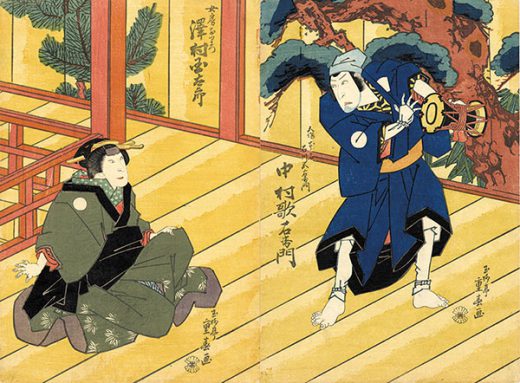Ukiyo-e: full of pine trees
December 3 (Tue), 2019 ~ March 1 (Sun), 2020
This museum exhibits ukiyo-e woodblock prints produced in Osaka in the Edo period. Most of the ukiyo-e prints made in Osaka were portraits of kabuki actors performing in kabuki plays in theatres mainly in Dotombori.
On kabuki stages a variety of stage scenery (such as nature like climate or plants) is used in order to describe seasons. Above all, trees not only color the stage (such as cherry blossoms for spring and colored leaves for autumn) but also can play an important role in a scene
In this feature exhibition, we focus on pine trees. Pine tree are evergreen so they are regarded as a symbol of longevity and good luck. Kadomatsu, gate pine, is placed in front of houses to celebrate new year, thus a pine tree has a good image. Pine trees also give a stage a profound taste. Other than that, pine trees have wider range of meanings in kabuki plays.
Enjoy how pine trees are used in kabuki.

Keisei Setsugekka
Drawn by Gyokuryutei Shigeharu
Actors: Sawamura Kunitaro II playing the role of wife Oritsu and Nakamura Utaemon III playing the role of Ishikawa Goemon
Pine tree
Pine is a general term of Pinaceae. They are coniferous evergreen. While widely distributed in the northern hemisphere, in Japan most of them are red, black and Japanese white pines.
The three (most amazing) views of Japan, Amano-hashidate (in Kyoto prefecture), Matsushima (in Miyagi prefecture) and Itsukushima (in Hiroshima prefecture) all have a pine-tree view. Pine tree groves (such as Miho-no-matsubara, one of the three most famous pine groves in Japan) are known as places of great view. There are many famous old pine trees of historical interest. In “Naniwa Hyakkei” (One Haundred Views of Naniwa), drawn by ukiyo-e artists in Osaka, Tako-no-matsu (in Nakanoshima area) and Fukushima sakaro-no-matsu are introduced as a great old pine tree.
These days there are less view with pine trees, but in a kabuki play “Kataki-uchi Sozenji no baba”, a vengeance scene is performed with a background of a pine grove around Sozenji-temple. In kabuki plays mikoshi-no-matsu (a pine tree seen over/from the gap of the wall) is often placed neatly in a garden, showing that people at the time loved pine trees.
Pine trees in kabuki plays
Pine trees are often drawn on fusuma (sliding door for partitioning rooms in Japanese houses) in castles by Kano School artists who worked for samurais including shogun. Because pine trees are evergreen, they have images of longevity and sacred. They also have a noble image. Therefore people place kadomatsu (gate pine) to celebrate new year and use sho-chiku-bai (pine-bamboo-plum, Japanese three plants that symbolize auspicious things) at a celebration.
There are genre of kabuki plays called “Matsubame-mono” (famous play “Kanjincho” is one of them). “Matsubame-mono” is a kabuki play that has a large (almost stage wide) panel with huge pine tree painted on it at the background of a stage to make the kabuki play look more sophisticated. This method comes from noh and kyogen (both are Japanese traditioinal dance-drama), showing the influence of these arts upon kabuki.
In a kabuki play titled “Sugawara denju tenarai kagami”, Matsuomaru, a person who keeps his loyality even though being seen as an enemy, is described as an evergreen pine tree. In this play, a poem is composed about him. It says; in a world that plum flies and cherry dies, pine would not stay as it is.
Pine tree pattern / design
Pine trees, also called tokiwagi (evergreen), live long and evergreen so they are used as an auspicious motif. There are variety of patterns using pine: wakamatsu (young pine), oimatsu (elderly pine), matsuba (pine leaves) and matsukasa (pine cone).
There are also a combination of auspicious motifs such as sho-chiku-bai (pine-bamboo-plum), wisteria around pine and snow on a pine tree.
Mikoshi no matsu : a pine tree seen over / from the gap of the wall
A famous popular song “Otomi-san” starts with this word ‘mikoshi no matsu”. This song originates from a kabuki play “Yowa nasake ukina no yokogushi”
Matsubame-mono
Imitating noh (Japanese traditional dance-drama) stage, a large elderly pine is drawn on a panel and placed at the center of the stage with bamboos on both sides, five-color cloths on the left side and okubyo-guchi (literally means “coward’s exit”, with a small sliding dorr) on the right side.
Yuki-mochi-mon (literally ‘snow-holding pattern’)
Pattern of snow that piles on grasses and trees. Patterns that describe beautiful winter scenery include yuki-moch-matsu (snow on pine trees), yuki-moch-yanagi (snow on willow) and yuki-mochi-sasa (snow on bamboo grass).
Kataki-uchi Sozenji no baba
Feudal retainers in Yamato Koriyama, Enjo Jizaemon and Shundo Ikuhachiro, brothers, try to kill their brother’s killer, Ikuta Denpachi. At a duel in front of Sozenji temple gate, Denpachi had many helpers hiding in the pine woods and the brothers are killed by Denpachi and his helpers.
Some-moyo-imose-kadomatsu
Osome, daughter of a pawn shop Aburaya, had an fianc?e but couldn’t give up her love with Hisamatsu, an apprentice of Aburaya. Osome didn’t obey her parents and her fianc?e Yanbe Seibei, committed suicide together with Hisamatsu on New Year’s Eve.